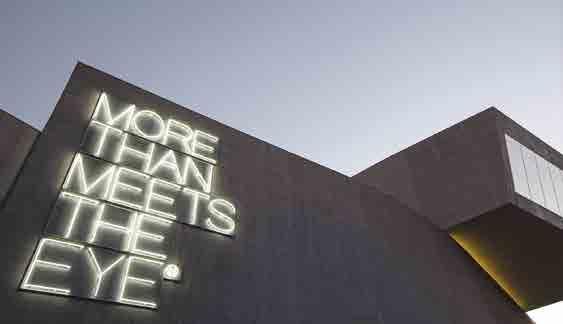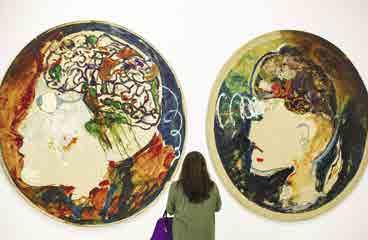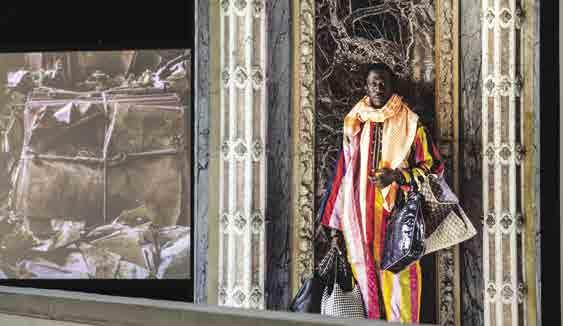
9 minute read
Merit Brings Value, I Saw it in a Museum
Merit Brings Value, I Saw it in a Museum
Meritocracy has long been hailed as a universal solution. But where it promises to tackle privilege and incompetence, it also encounters the need for action, to take steps to make it tangible and translate the principle into value.
Advertisement
In the arts, meritocracy means representing a wide community and giving space to the complexities that are a sign of our times. Here is how MAXXI put this principle into action.
BY GIOVANNA MELANDRI — PRESIDENT OF THE MAXXI FOUNDATION
An excellent prompt, a complicated topic, the state of meritocracy in the arts. Especially in the context of the mission and experience of a museum of contemporary art, so fluid and uncertain, interdisciplinary and volatile. My overview is in the context of Maxxi's recent one-decade milestone. An adventure that was in many ways new to the Italian landscape, that was enriched as it went, creating an increasingly fertile relationship with parallel institutions and artistic communities. With so many interlocutors and so much hype, the dialogue developed around years of research and exchange of new suggestions and expressive proposals, breathing an international air into our challenge. A museum thrives off beauty, planning ability and passion: it lies in heritage and in exhibition, education, training and civic activity. The works in our collection and exhibitions are not only the fruits of individual labour – they are the product of research, of a team effort, of visions, skills and talents aligned and harmonised, to capture the profound inspiration of the artists and to touch every visitor. It is dedication, a dialectic game, a space for perception that is tested as part of a buzzing workshop every day, a laboratory of the future, as MAXXI considers itself; the result of collective intelligence that emanates from an ongoing dialogue between different backgrounds and fields. This is a prerogative we take very seriously, an approach that underpins the premise of any success.

The sentence “More than meets the eye” (by Maurizio Nannucci) encourages visitors to immediately look at this museum as more than just what it exhibits.
MUSACCHIO, IANNIELLO, PASQUALINI — COURTESY FONDAZIONE MAXXI
Merit is, or should be, the basic ingredient for supporting us on this journey, between duties and limits that no system can believe itself to be free of. However, I am not here to make abstract declarations or claims of responsibility for a given situation. The space afforded to merits, to growth and evolution of a cultural institution is not an objective attained in perpetuity, entrusted to casual or occasional exploits. It is a method that is constructed with care, as part of a coherent strategy. The people who dedicate themselves to it come with specific backgrounds in terms of education and training, professions in a multitude of areas – invention, production, communication, education, management – the “engine-room” of any museum. In our case, a museum that is a work of art in itself, created by the much-missed architectural genius of Zaha Hadid, a structure and meeting space rooted firmly in the tradition of Classical, Renaissance and Baroque Rome.
I will begin with a thought that is seemingly only partially self-evident: the identity of a national museum of contemporary art lies first and foremost in the value assigned to its works of art. This is a highly delicate and multifaceted process, one that is challenging to get objectively right once and for all. We do, however, have a “compass” to help us find our bearings and enhance the quality of our offer, and this is the value we assign to the judgment and the role of the curator. Their role – proposing and mediating between the artist, their original context, the public and the exhibition space – is vital for a museum’s development. A good curator (at MAXXI we have an all-female team!) will have a clearly defined aesthetic philosophy, a certain taste, a familiarity with the creative industries in the globalised age and an innovative spirit to blend into a potent mix of a vision, promotion and distribution without equal.
The benefits in working with a curator filter through into every aspect of an exhibition: they are the thread that links the author or the study in its historical context, the vision and its staging, the conceptual content, the element of its communication. For me, a “meritocratic” museum is first and foremost a space that affords value to its curatorial decisions. This is the exact opposite of two contemporary trends: it fundamentally challenges the bizarre belief that the cultural industries, from art to music, to publishing, can afford to engage in disintermediation and do without specific, detailed, tried and tested skills and roles; and shelters a museum from the need to act in accordance with the logic and value scales defined solely by the market, towards an artist or a work or a trending school of art. By emphasising curatorial responsibility, we choose not to indulge in market-driven or populist visions – as we shall refer to them for simplicity’s sake. Rather, we equip ourselves with antibodies to fully reflect the mission of a national museum of contemporary arts. And yet, such a vital role does not enjoy the necessary formal professional recognition: there is no official register of curators, no specific programme of study and training to serve as an indispensable aid for those wishing to follow this career path.

Exhibition: “senzamargine” — MAXXI Museum October 2, 2020 / January 30, 2022 — Mario Schifano, Dolore, 1990 - mixed technique Courtesy: Jacorossi Collection, Rome.
MUSACCHIO, IANNIELLO, PASQUALINI — COURTESY FONDAZIONE MAXXI
Another salient aspect I wish to touch on concerns responsible governance. An institution such as MAXXI must remain viable, be effective and efficient in its use of the public and private resources at its disposal, have a management team equipped to balance the multiple missions – artistic, cultural, spiritual, civic – necessary to provide enrichment tools and activities for people and “guides” to critical thinking within the community. MAXXI is held by a private foundation under public control, a largely unfamiliar system in Italy. The hands of the State and the market (sponsors, patrons, marketing) are clasped together, overcoming differences, tackling thorny issues, developing collaborations.
A museum that rests on healthy foundations is a museum with more “freedom” to carry out research and to facilitate dialogue across ideological or geopolitical barriers; it is a museum that makes an original contribution to a society’s knowledge. Its raison d’être contains a spark for us all, and to different kinds of leadership, using the regenerative powers of intuition, revision, and dissidence that only artistic creativity can provide. But these ambitions are all unattainable if the museum in question does not have exceptional administrative, legal, fiscal, commercial, and communication resources in place. MAXXI offers all of these, as well as other new and shifting professional figures, in the different areas linked to the ongoing evolution of a cultural institution. We are a proving ground for young people who have recently finished studies and specialisations, where they can apply their skills in a core space for generating and evolving the culture of a proud country. I am drawn to note, for example, the recent digital trend that introduced new manners and meanings not only in MAXXI’s means of communication but also in its profile as a creative and artistic hub. The impact of the pandemic on this process is clear, undoubtedly, but above all there is a promptness and readiness to emphasise the skills that we were all able to grasp and develop.

Exhibition: "African Metropolis" — MAXXI Museum June 22, 2018 / November 4, 2018
MUSACCHIO, IANNIELLO, PASQUALINI — COURTESY FONDAZIONE MAXXI
The third important point is recognising the value of the public’s judgment and seeking to “connect” with it in a meaningful way. I am referring to the logical and strategic leap necessary to shift a meaningful part of State resources from supply to demand in terms of culture. This has long been a keen area of interest for me and now, in view of the available options for the post-pandemic recovery, we have the opportunity to move from words to deeds. It is the financial lever that we must pull, allocating families and their consumption a sum of money that today is “automatically” distributed to the various producers of culture. It is finally time to give the people, as the consumers of culture, a valid choice: to be able to deduct an appropriate sum from their tax claims on the expenses associated with visiting and “living” theatres and cinemas, auditoriums and museums, archaeological parks. This would mean expanding and updating the frontiers of our welfare system, reducing the financial burden but above all, giving meaningful value to the freedom and autonomy of the "cultural consumer", giving them a leading role. To clarify, this does not mean reducing the supply in terms of artistic and cultural production. But a system that creates this “revolution” is an inherently more meritocratic one, in part because it lightens the random and “horizontal” dimension of the destination of public funds: where to support and how to reward innovation, modernity, experimentation. The merit of a cultural institution is in representing an open community, facing the world and its contradictions, without raising walls, and giving space even to the most critical and intricate visions of our age. I recall exhibitions that MAXXI pushed relentlessly, selecting and welcoming ‘uncomfortable’ artists who had been ostracised in their own countries, along the borders of Iran and Turkey, from Lebanon, the former Yugoslavia and Africa, in accordance with our mission to build dialogue between ethnicities, traditions, and historical heritage in the Mediterranean and Middle East. I also think of the unceasing commitment to educating towards beauty and professional training that is an engine of MAXXI’s work: we are a museum that attaches great importance to the value and merits of study and art as a research and innovation institute. In a single decade, we have opened our doors to over 5,000 activities and workshops with 125,000 children, young people and adults, printed 120 publications and forged ties with around 40 universities and academies in Italy and abroad. And last of all, I think of the care we take to ensure the museum is truly accessible to everyone, the final stages of the MIXT project, created in collaboration with organisations for the deaf and blind: this offers every visitor an opportunity to expand their knowledge and actively experience MAXXI. Cultural diversity, “didactic agency”, accessibility: these are added values and objectives to strive towards. In short, we do not want the idea of giving space and meaning to meritocracy to remain a sterile slogan.

Born in New York in 1962, lives in Rome. Married with one daughter. Economist, environmentalist and an expert in cultural policy. Minister of Cultural Heritage and Activities (1998 - 2001) and Minister of Youth Policies and Sporting Activities (2006 - 2008). President of MAXXI, the national museum for contemporary art, since 2012. Founder and president of the Human Foundation, created to promote innovation, social finance and models of evaluating impact within the Italian economy, and of the Italian Social Impact Agenda, the Italian branch of the international movement of the “impact economy”. Since 2018, on the board of trustees of the GSG (Global Steering Group for Impact Investment). She writes the “Impact Economy” feature in Repubblica Affari&Finanza. She writes regularly for Huffington Post, Vita and Corriere della Sera - Buone Notizie. She loves the mountains and meditation.










